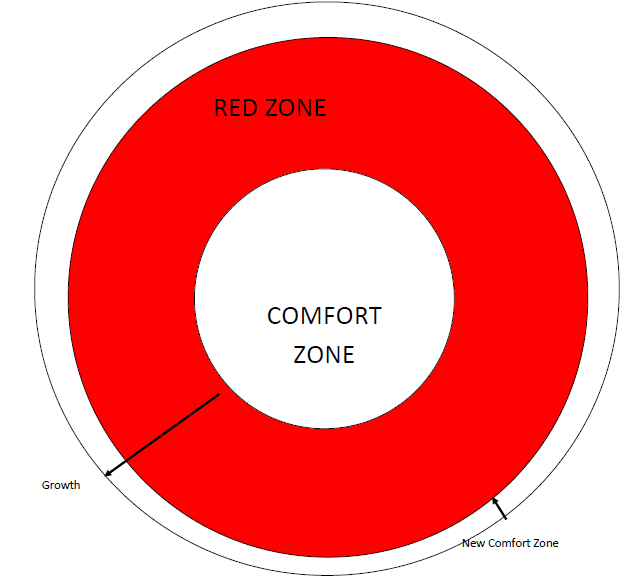“Life begins at the end of your comfort zone.” – Neale Donald Walsch
Stepping outside our comfort zones is crucial to developing as a leader. Our willingness to try new things, master new skills or merely do things that take us beyond our comfortable and safe ‘every day’ lives is vital if we wish to continue growing, developing and reaching our full potential.
We all know that somewhat uncomfortable feeling when we are outside our comfort zone. The question is, how does this process actually work?
It all begins with the fight or flight response, where the sympathetic nervous system responds to a perceived threat by increasing heart beat and respiration, decreasing digestion, and turning the face white, as the blood rushes to the muscles to get ready to flee!
Sometimes challenges can evoke the fight or flight response, due to feeling nervous, threatened, or simply from being outside the safety of our comfort zone.
The place where we experience this phenomenon can be coined as The Red Zone.
The term ‘red zone’ was originally coined in American football. It alludes to the 20 yards before the goal line where progress is the most difficult, because it is the most fiercely defended area.
But it is also in this zone that breakthroughs have the greatest ‘pay-off’.
Here is a simple exercise to understand the importance of pushing through The Red Zone.
Firstly, focus on a task in your job where you are in your comfort zone – the sort of task that is so easy, you can do it with your hands tied behind your back.
What are some of the positive feelings associated with being in the comfort zone of that particular activity (such as feeling confident)?
Now think of some negative adjectives which describe the feelings attributed to being in that comfort zone (like boredom).
Next, picture something in your role where you are outside your comfort zone. For example, having a ‘difficult conversation’, speaking in front of a group, or another activity you are still learning, and perhaps have not yet mastered.
What are the negative feelings you experience in this situation?
And, what are the positive feelings associated with this experience of being outside your comfort zone?
Here’s the rub. If we move into the red zone but do not stay there, despite feeling awkward or uncomfortable, but instead retreat back into our comfort zone, two things happen.
Firstly, our original comfort zone gets smaller, which over time leads to less risk taking and a lack of growth and excitement.
Secondly, we experience a heightened sense of the negative feelings associated with being inside our comfort zone; that feeling of boredom often returns with a vengeance.

Pushing through The Red Zone can feel like falling from a great height, however the benefits are well worth the effort. Image Source: Flickr Commons.
Strive to recognise when you are in the red zone. And then, have the courage to stick with it and reap the benefits.
Sooner or later, you will find what was originally in your red zone will become your comfort zone (which is now bigger).
NOTE: I would like to express my thanks to Mary and Julia from The Sales Training Company for introducing me to the ‘red zone’ concept.






[…] intelligence wanted to continue doing easy puzzles, which they knew they were good at (within their comfort zones, not wanting to try something new for fear of failure). By contrast, the children praised for […]
[…] I rediscovered the beauty of stepping outside the proverbial comfort zone. […]
[…] Learn to love learning new things. Regularly getting out of your comfort zone and into your red zone with your skill development is a surefire way to build self efficacy. An executive coach can also […]
[…] all leadership attributes, the first time we do it can seem awkward. But by pushing through the Red Zone, we eventually become comfortable with being uncomfortable – and in the end, it’s a win/win […]
[…] initial response will be anger, defensiveness, hurt or tears. This can be tied up with the fight or flight response. If this happens, do not take it personally. Often, people require time for reflection – […]
[…] Widens our circle of understanding and experience (refer to my Pushing Through the Red Zone blog). […]